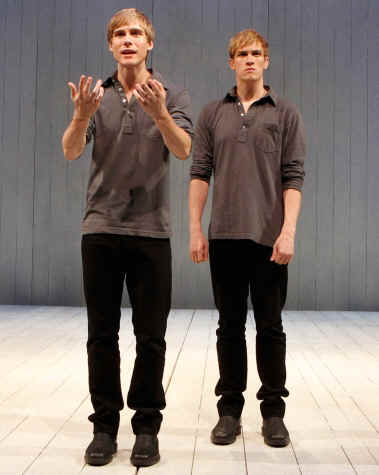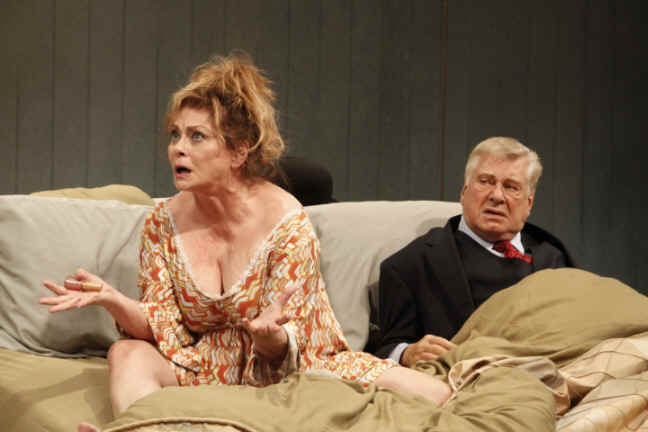|
Since his very first produced play, The Zoo Story (1958), a taut two-hander with a tragic ending, Edward Albee has been famous for his sharply observed, verbally cutting naturalistic dramas. It’s easy to forget that, from the very beginning, Albee has also produced a parallel string of stylized absurdist comedies, starting with
The American Dream (1960), full of playful theatricality and characters with generic names like He and She or Mommy and Daddy. In recent years, we’ve seen a lot of major-key Albee with Broadway revivals of
A Delicate Balance and Who’s Afraid of Virginia
Woolf?, as well as the Tony Award-winning The Goat, or Who Is Sylvia? His new play,
Me, Myself & I, staged by Emily Mann at Playwrights Horizons in New York, falls soundly into the other, decidedly minor mode.
It revolves around a pair of 28-year-old identical twins and their mother, who’s so monstrously self-involved that she can’t tell them apart. “Which one are you?” says Mother, played by Elizabeth Ashley as a fabulous frazzle, propped up in bed next to her elderly doctor boyfriend (Brian Murray), who’s fully dressed in three-piece suit. “Are you the one who loves me?” Clearly, everything about the twins’ lives has been arranged for her convenience, including their names: OTTO and otto.

All-caps “loud” Otto (Zachary Booth, above left) precipitates a family crisis with three announcements: 1) he plans to become Chinese; 2) he’s decided that his brother (Preston
Sadleir, above right) doesn’t exist and he’s replacing him with the image of himself he sees in the mirror, whom he names Otto in italics; and 3) he’s tracked down the father who disappeared as soon as he heard Mother was pregnant with twins.
Possibly imaginary offspring figure in several of Albee’s plays, and there’s some biographical background to that. It’s well-known that the playwright was adopted by a wealthy, highly intellectual, emotionally cold couple from whom he chose to distance himself as an adult. Only after his mother’s death did Albee learn that before he was adopted, his birth mother had named him Edward Harvey.
Me, Myself & I in some way is his way of contemplating the relationship between the Edward of his birth certificate and the Edward whom his adoptive family raised. But you don’t have to be adopted to fantasize what your life would have been like if you had grown up in a different environment.
At its best, Me, Myself & I is an extended theatrical prank that pays homage to Albee’s roots in what critic Martin Esslin labeled Theater of the Absurd, a somewhat dodgy catch-all to describe the playwrights who emerged from the existential funk of post-World War II Europe. The minimalist set and language of
Me, Myself & I refer explicitly to Beckett, one of Albee’s heroes, just as the replication of names pays homage to Ionesco (who once wrote a children’s story about a family whose members were all named Jacqueline). And the play’s self-referential theatricality has its roots in Pirandello
(Six Characters in Search of an Author).
OTTO speaks directly to the audience, announces the intermission and curtain call, and makes the hilarious assertion that Western theater has its own version of the bunraku tradition that the puppeteers’ black costumes render them invisible: “If you lean against the proscenium, the other people in the scene don’t see you.” The long-lost father rises up from a trapdoor in an enormous emerald-laden chariot driven by merry-go-round panthers, under a banner announcing “The Happy Ending” (sexual pun always intended, in Albee’s world). And the endless banter about existence and identity can be read as philosophical musing on the elusive nature of theatrical reality. In what sense does a character in a play exist, really? You could ask the same question about God, or self. If such a thing resides only in imagination, does it actually exist?

For all the grist it provides for term-paper writers, though, as a live theater experience
Me, Myself & I is pretty thin stuff. Minutely debated wordplay, echoed phrasing, and quasi-musical repetition may be amusing to the author, but to the audience it quickly became tedious to the point of irritation. This isn’t always the case with Albee in existentialist mode.
The Play About the Baby, which was produced in New York in 2001, explored a similar story (an older couple steals a baby away from a young couple and then tries to convince them the baby never existed) with a cartoonish abstraction that nevertheless conveyed great depth and charm, perhaps thanks to director David Esbjornson and a terrific cast headed by Marian Seldes and Brian Murray. I wound up feeling a little embarrassed for the actors in
Me, Myself & I, especially the admirable veterans Ashley and
Murray (above). The director hasn’t helped them find much more than the one note they’re given to play by the author. Booth performs his tasks remarkably well (including frolicking naked briefly), valiantly humoring Albee as he indulges himself in long leisurely strokes of verbal self-pleasuring.
Otto-eroticism can sometimes be a lot of fun to witness, but not this time.
CultureVulture.net, September 29, 2010
|